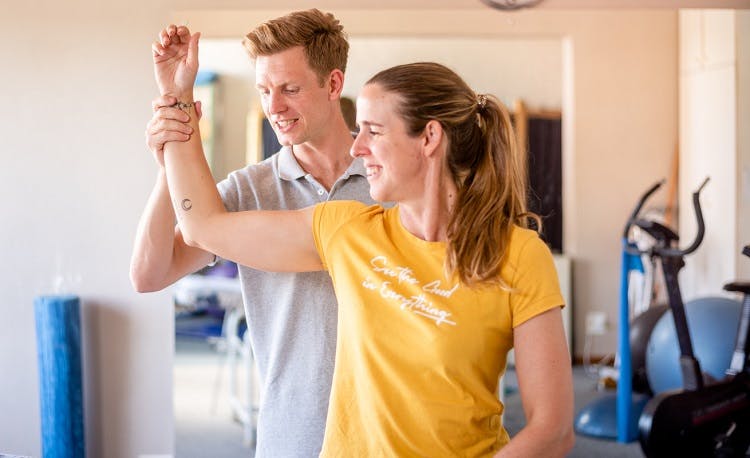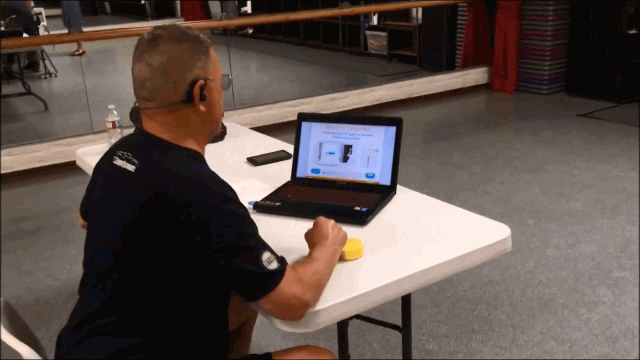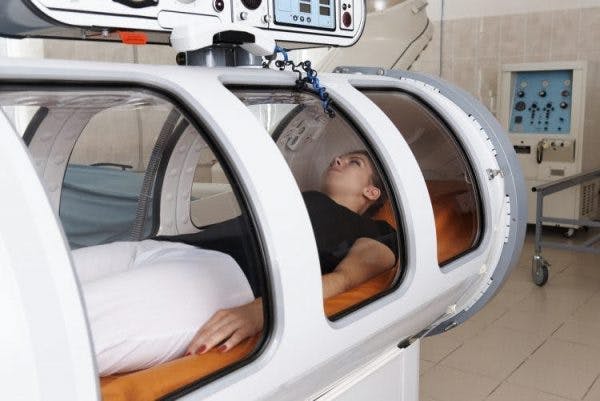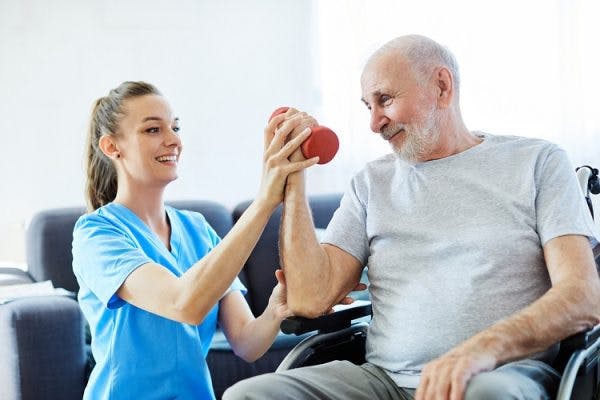Brown-Séquard syndrome is a rare form of incomplete spinal cord injury characterized by weakness and/ or paralysis on one side of the body, with specific changes in sensation present on both sides of the body. This may affect an individual’s balance, walking ability, and coordination. Fortunately, many individuals with this condition are able to learn effective strategies to improve affected functions and maximize their quality of life.
To help you understand Brown-Séquard syndrome, this article will discuss its:
Brown-Séquard Syndrome Causes
Brown-Séquard syndrome is caused by damage to one side (left or right) of the spinal cord. It is most common following traumatic blows to the spinal cord such as knife attacks or gunshot wounds; however, it can also be caused by many other events, including:
- Cervical spondylosis
- Arachnoid cysts
- Infections
- Multiple sclerosis
- Tumors
- Spinal vascular diseases
Brown-Séquard syndrome is a rare form of incomplete spinal cord injury, making up about 2-4% of all SCIs. It most commonly occurs following injuries to the cervical or thoracic regions of the spinal cord, which make up the neck and upper region of the back.
Depending on the location and severity of the injury, Brown-Séquard syndrome can manifest in many different ways. The following section will discuss its characteristic signs and symptoms.
Brown-Séquard Syndrome Symptoms
Pure forms of Brown-Séquard syndrome rarely occur. As a result, the severity of symptoms below the level of injury can vary significantly from person to person.
Common signs and symptoms of Brown-Séquard syndrome include:
- Ipsilateral loss of deep sensation. Deep sensation includes the sense of where your body is positioned in relation to space (proprioception) and the sense of vibration. When symptoms are ipsilateral, it means that they occur on the same side of the body as the spinal cord injury. For example, if you sustain damage to the right side of the spinal cord, then you may experience deep sensation deficits in the right side of the body.
- Ipsilateral loss of motor control. Many individuals with Brown-Séquard syndrome exhibit loss of motor control in the same side of the body as the spinal cord injury. As a result of one-sided weakness/ paralysis, individuals may experience difficulties with balance, walking, and performing everyday activities. Additionally, functions like bowel and bladder control may be affected.
- Contralateral loss of pain and temperature sensation. Individuals often experience pain and temperature abnormalities on the opposite side of the body in which their injury occurred. For example, injury to the right side of the spinal cord may affect the sense of pain and temperature on the left side of the body.
In addition to these characteristic symptoms of Brown-Séquard syndrome, individuals may also be at-risk for general secondary effects of incomplete spinal cord injuries such as spasticity, pressure ulcers, and muscle atrophy. Fortunately, many individuals with Brown-Séquard syndrome are able to overcome these complications and improve their mobility.
Brown-Séquard Syndrome Prognosis
Generally, individuals with Brown-Séquard syndrome have favorable recovery outlooks. In fact, studies show that 75-90% of individuals with Brown-Séquard syndrome are able to recover their walking abilities by the time they are discharged from rehabilitation.
Recovery after incomplete spinal cord injury is possible because the central nervous system (the brain and spinal cord) is capable of utilizing neuroplasticity. Neuroplasticity allows the spinal cord to make adaptive changes and rewire its neural circuitry. As a result, functions affected by spinal cord injury may be able to be reorganized to unaffected regions and strengthened through repetitive practice.
Because Brown-Séquard syndrome only affects one side of the spinal cord, the neural pathways in the unaffected side are often able to utilize neuroplasticity to take on affected functions and improve them.
The key to promoting neuroplasticity is to stimulate the spinal cord through the massed practice of weakened functions. In other words, by consistently practicing weakened movements, you’re stimulating the spinal cord and reinforcing demand for those functions. The more you practice, the stronger the newly rewired pathways for that function become.
Treatment of Brown-Séquard Syndrome

Treatment of Brown-Séquard syndrome should focus on promoting neuroplasticity to restore communication between the brain, muscles, spinal cord, and peripheral nerves. Participating in rehabilitative therapies can help identify your specific weaknesses and target them to promote functional recovery.
Below, we’ll discuss several interventions that may help promote recovery.
Physical Therapy
A physical therapist can help individuals with Brown-Séquard syndrome practice exercises to improve motor control on their affected side. Continuously practicing exercises with the affected side will improve strength and range of motion. Additionally, it will stimulate the spinal cord and promote neuroplasticity.
To help individuals with Brown-Séquard syndrome recover their mobility, therapists may recommend a technique known as constraint-induced movement therapy. It involves constraining use of the unaffected side (usually of only the upper extremity) to force use of the affected side. The individual then participates in intensive training of the affected side to promote neuroplasticity.
While extreme, this highly repetitive and intensive training provides the spinal cord with the stimulation necessary to make neuroadaptive changes and improve affected functions.
Occupational Therapy
Occupational therapy can help individuals with Brown-Séquard syndrome maximize their functional independence. Generally, this involves practicing activities of daily living such as dressing, performing transfers, or preparing a meal.
While many individuals with Brown-Séquard syndrome have the potential to recover motor functions, it will take time and effort. Therefore, an occupational therapist may teach them compensatory strategies such as using adaptive tools to help them get by as they work on improving their mobility.
Occupational therapy can also involve preparing individuals to return to school or work. An occupational therapist may teach the client about disability rights and how to advocate for themselves and request accommodations. Sensory deficits and safety strategies surrounding altered sensation are also often addressed during occupational therapy.
Orthotics
Your doctor or physical therapist may recommend wearing orthotics like braces or splints on your affected side to provide musculoskeletal support. Orthotics help hold your affected limbs in place to minimize the risk of injury, prevent further tightening of spastic muscles, and promote better form.
Botox Injections
Many individuals with Brown-Séquard syndrome experience involuntary muscle contractions known as spasticity in their ipsilaterally affected side. This can restrict range of motion and make it difficult for individuals to participate in daily activities and physical therapy.
To temporarily reduce high muscle tone, nerve blockers like Botox may be recommended. Unlike oral muscle relaxants (that affect the entire body), Botox is directly injected into spastic muscles. It blocks the signals that cause muscles to contract, allowing individuals to practice therapeutic exercises without the impact of spasticity. Improvements made while using Botox are often able to carry over even after its effects have worn off due to neuroplasticity.
Speech Therapy
As mentioned earlier, many cases of Brown-Séquard syndrome are caused by damage to the cervical or thoracic regions of the spinal cord. Spinal cord injuries at these regions may impair control over major respiratory muscles such as the diaphragm and intercostal muscles. As a result, individuals may experience difficulties breathing and have an increased risk of developing respiratory complications.
A speech-language pathologist can evaluate the severity of breathing difficulties and suggest exercises to improve control of the respiratory muscles.
Home Exercise
The key to recovering functions affected by spinal cord injury is to repetitively practice them. Individuals can boost their recovery by making sure they also practice targeted exercises at home.
Whether you’re experiencing difficulties staying motivated to practice or your insurance no longer covers therapy, investing in home rehabilitation devices like FitMi can help you practice the repetitions necessary to promote Brown-Séquard syndrome recovery.
FitMi is a home therapy program that makes repetitive exercise fun. It turns your everyday exercise session into a game and challenges you to perform a certain amount of repetitions before time runs out. By making rehabilitation more engaging and motivating, individuals are more likely to see functional improvements.
Brown-Séquard Syndrome: Key Points
Brown-Séquard syndrome is a type of incomplete spinal cord injury caused by damage to one side of the spinal cord. Consequently, individuals generally experience loss of motor control and deep touch on the same side as the lesion and loss of pain and temperature sensation on the opposite side of the body.
Fortunately, there is generally a positive recovery outlook for individuals with Brown-Séquard syndrome because the spinal cord is capable of utilizing neuroplasticity. However, individuals must put in the effort and participate in intensive training to promote recovery.
We hope this article helped you understand what Brown-Séquard syndrome may affect the body and how to treat it.












